How to Introduce Allergenic Foods to Your Baby
- What the Top 9 allergenic foods are and how you can use real food to introduce them to your baby
- What to do if your baby has an allergic reaction to food…and why they are unlikely to die from that
- How to safely introduce all of the Top 9 allergenic foods in the first 9 weeks after starting solids
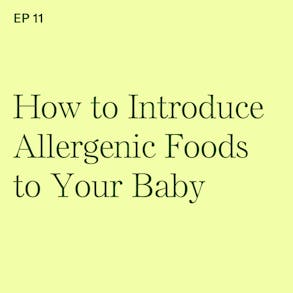
LISTEN TO THIS EPISODE
Episode Description
What if your baby has an allergic reaction to a food? The only way to know if your baby is allergic is to offer them that food…but there are some safety guidelines you want to know about.
In this episode we’ll look at the recent research and updated guidelines that support early introduction of potentially allergenic foods and then how to safely prepare those foods to help lower your baby’s risk of food allergy.

Links from This Episode
- Puffworks Baby peanut and almond puffs for introducing 2 separate allergenic food categories (peanut and treenut) are available for 15% off with affiliate discount code BLWPOD - shop here
- Baby-Led Weaning with Katie Ferraro program with the 100 First Foods™ Daily Meal Plan, join here: https://babyledweaning.co/program
- Baby-Led Weaning for Beginners free online workshop with 100 First Foods™ list to all attendees, register here: https://babyledweaning.co/baby-led-weaning-for-beginners
Other Episodes Related to This Topic
- Episode 58 - What do I do if My Baby Has an Allergic Reaction? with Ron Sunog, MD
- Episode 227 - When Does the Food Allergy Prevention Window Close? with @allergykidsdoc David Stukus, MD
- Episode 380 - Why Doctors STILL Aren't Talking About Introducing Allergenic Foods with Ruchi Gupta, MD, MPH
Resources and Research
- Du Toit, George et al. “Randomized trial of peanut consumption in infants at risk for peanut allergy.” The New England journal of medicine vol. 372,9 (2015): 803-13.
- Fiocchi, Alessandro et al. “Food allergy and the introduction of solid foods to infants: a consensus document. Adverse Reactions to Foods Committee, American College of Allergy, Asthma and Immunology.” Annals of allergy, asthma & immunology : official publication of the American College of Allergy, Asthma, & Immunology vol. 97,1 (2006): 10-20; quiz 21, 77.
- Tran, Maxwell M et al. “Timing of food introduction and development of food sensitization in a prospective birth cohort.” Pediatric allergy and immunology : official publication of the European Society of Pediatric Allergy and Immunology vol. 28,5 (2017): 471-477.
- Perkin, Michael R et al. “Enquiring About Tolerance (EAT) study: Feasibility of an early allergenic food introduction regimen.” The Journal of allergy and clinical immunology vol. 137,5 (2016): 1477-1486.e8.

Latest Episodes
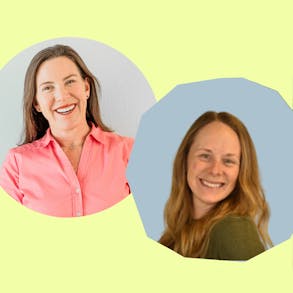
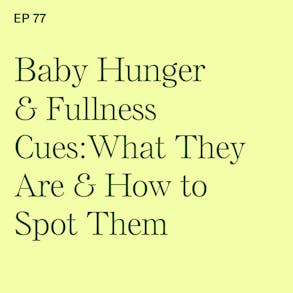
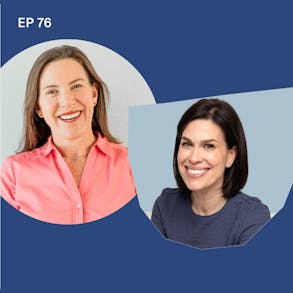
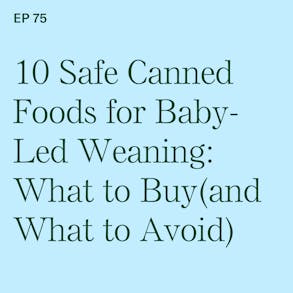
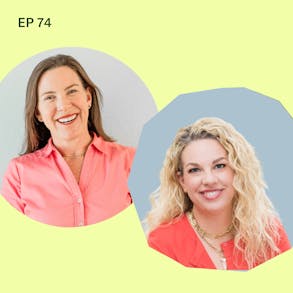
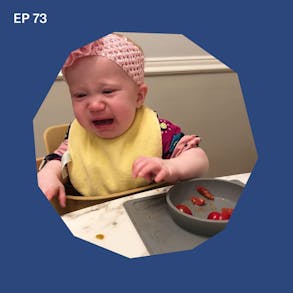
Katie Ferraro (0s):
And I was so inspired by this bond because despite the fact that her baby had confirmed food allergies, they were still introducing one low risk food per day and also the remaining allergenic foods the baby was not allergic to once a week. And instead of thinking about all the foods that baby couldn't eat they instead, were looking at it as gosh, thinking about all the foods out there that our baby can eat. Hey there, I'm Katie Ferraro, Registered dietitian, college nutrition professor, and mama of seven specializing in Baby-Led Weaning. Here on the Baby-Led Weaning Made Easy podcast I help you strip out all of the noise and nonsense about feeding, leaving you with the competence and knowledge you need to give your baby a safe start to solid foods using Baby-Led Weaning.
Katie Ferraro (51s):
Hey guys and welcome back to the Baby-Led Weaning made easy podcast. This is your host, Katie Ferraro, Registered dietitian and mom of seven specializing in Baby-Led Weaning today's episode. We are going to be talking all about how to introduce allergenic foods to your baby. Perhaps a more appropriate title would be why do we introduce allergenic foods to our baby? Because you might be surprised to learn that the guidance for introducing allergenic foods to babies today differs wildly from what it looks like just a few decades ago. So today I'm going to share with you some practical tips on how you can get over your fear of introducing these allergenic foods.
Katie Ferraro (1m 36s):
Because for many parents, the thought of giving their baby something like let's say, shellfish can be like sheerly anxiety inducing. I want to help strip away that fear for you by talking about the current state of science and evidence that we have, the body of knowledge. We know now that shows us that earlier introduction actually helps prevent against food allergy down the road. So as I do with all episodes, I want to start you off with a Baby-Led Weaning tip of the day. And since we're talking about potentially allergenic foods, my tip of the day is you want to introduce the big eight allergenic foods to your baby early and often.
Katie Ferraro (2m 18s):
Now the next question many parents ask what are the big eight allergenic foods? And these are the eight foods that account for about 90% of food allergy. I'll go through them in a second. But for some of these allergenic foods, we've got in recent years, a very dramatic shift in our understanding of how we introduce these to babies. Old guidance used to say, you had to wait and that it appeared to be beneficial to wait to introduce these foods in order to prevent allergy. But the tide has totally shifted. And we now have updated data that supports the early introduction to prevent allergies such as peanut and egg and milk.
Katie Ferraro (2m 58s):
And even if you look at the data, much of which is still under study, we don't fully, of course understand food allergies. We're still learning about them, but it does not appear that it's beneficial in any regard to wait to introduce these. So again, we used to tell parents 20 years ago, and I was studying to be a dietitian. We certainly learned about the benefit of waiting and we kind of learn nutrition, counseling techniques that I always felt would often scare parents. No, don't do those foods. That's going to cause allergy. Now the recommendations are totally different. It doesn't appear that waiting has any benefit in actually in the case of some of these allergenic foods, there appears to be a protective mechanism.
Katie Ferraro (3m 41s):
If you introduce the foods early, so hang tight because in this episode, I'm going to walk you through the big eight allergenic foods. I'll explain a recommended sequence for introducing new foods to your baby. That will allow you to introduce all eight of these foods safely. And within the first two months of starting solid foods with Baby-Led Weaning, right? Because your baby doesn't just magically wake up on their first birthday and say, I hope you fed me all of those big eight allergenic foods. And some of these might not just magically appear in your baby's diet. You have to be a little purposeful cause some of these are not your traditional or typical baby foods, but throughout the podcast, I'll be sharing very easy ways you can offer food based versions of the proteins that might potentially cause allergy in babies.
Katie Ferraro (4m 31s):
We're going to do that early and often. So I want to start by telling you a story about a mom named Meg. I met her recently. She's a breastfeeding mom who has a daughter who at the age of seven weeks. So seven weeks after she delivered, the parents noticed blood and mucus in the baby's stool. And eventually the mom was counseled to cut out dairy and soy from her diet. So as to not pass, whatever the offending compounds were through her breast milk to her baby. So the baby's dad gets a little more interesting has tree nut and peanut allergies. And so after a few mild reactions to certain foods, the baby was trying at six months of age with Baby-Led Weaning, the family eventually did have enough convincing evidence that it was time to get some allergy testing.
Katie Ferraro (5m 22s):
And Meg's baby was confirmed to have cashew allergy, pistachio allergy and peanut allergy. Now, interestingly, they did a wider array of tests. It turns out she was not allergic to some other tree, nuts, almonds, Brazil, nuts, hazelnut pecan Walnut, also not allergic to coconut or Sesame seed. And what's interesting there is that you, even though tree nut is one of the categories of food allergies. You can be allergic to some tree nuts and not to others. And so this baby is allergic to peanuts and a few tree nuts. So if you're allergic to peanuts, you're at higher risk for allergy to certain tree nuts and tree nuts, vice versa with peanuts, but it's not necessarily that you would be allergic to both right, regardless, but I think is so interesting about Meg's story is that despite her daughter's established food allergies, the parents continue to offer the baby one new food per day.
Katie Ferraro (6m 14s):
They were even working through the remaining allergenic foods. Now you don't do one of those everyday. I'll talk a little bit about the difference between low risk foods and then the introduction of allergenic foods, because we treat them a little differently with regard to the time that we wait in line between, but Meg and her husband, they introduced a wide variety of foods early and often, despite the fact that this baby had other established food allergies. And when I started following her story and speaking with her, I was so inspired by the fact that Meg and her husband, really, instead of taking some of these diagnoses and being scared and not wanting to try new foods and lamenting all of the foods that their baby couldn't eat, because she had these food allergies, they chose instead to focus on the wide variety of foods out there that their daughter was not allergic to and that she could safely eat.
Katie Ferraro (7m 8s):
And they worked using Baby-Led Weaning to find innovative ways to introduce this wide variety of foods. Now they are working closely with the pediatric allergist. The family's very educated about food allergy and really interested in the research and the latest guidelines and the latest guidance about introducing foods. So rather than being scared, they educated themselves rather than holding back on introducing new foods. They actually embraced the way variety of foods that were out there. That daughter was still not allergic to. And so their daughter at just past 10 months of age is approaching a hundred different foods that she has eaten with Baby-Led Weaning. And think about that.
Katie Ferraro (7m 48s):
I'm so inspired by a mom whose baby has some pretty severe and scary food allergies who still has the gumption and the courage to go and introduce this huge variety of foods to her baby, because she understands that the research also shows us that babies who are exposed to the greatest variety of foods and flavors and tastes and textures early and often, those are the babies who become independent eaters and they're less likely to be picky eaters. So let's take a look at the big eight allergenic foods. Now the big eight allergenic foods are the eight foods that account for about 90% of food allergy.
Katie Ferraro (8m 29s):
I'm going to link to the list, the big eight foods in our show notes. So you don't have to write these all down, but if you go to BMWpodcast.com/11, this is episode 11 and you can find these resources there. Another great resource for learning about food allergy is the food allergy resource education fair. And if you go to the website, foodallergy.org, I'm looking it up right now to make sure food allergy research and education. Again, that's foodallergy.org. They have great information about the big eight allergenic foods and a lot more information there about identifying potentially allergenic ingredients.
Katie Ferraro (9m 11s):
And how do you respond, how it differs in children, etcetera, but the big eight allergenic foods just to run down the list. These are the eight foods that account for 90% of food allergy, they include milk, egg, peanut wheat, soy tree, nut fish, shellfish, and Sesame. So again, those are the big eight allergenic foods. It is important that we introduce these foods early and often. If you are learning about Baby-Led Weaning, then you're likely aware that a baby who is six months of age plus exhibiting the other signs of readiness to feed can safely eat food based versions of all of these different allergenic foods.
Katie Ferraro (9m 53s):
You don't have to buy expensive medical products. You really don't have to overthink it. We want to offer these foods safely. And again, throughout the podcast, I'll be giving, doing different episodes featuring each of these allergenic foods. But I want to talk today about what I think are the three easiest allergenic foods to introduce. And they are also correlate with being the most common pediatric food allergies. So of the big eight, you don't have to introduce them in any particular order. However, I think it makes sense to start with three foods that are easy to feed early eaters. So if we're starting at six months of age, even the first week of starting solids, I recommend introducing one allergenic food.
Katie Ferraro (10m 37s):
And the three that I start with are milk, egg, and peanut. So again, milk, egg, and peanut are the most common pediatric allergen foods make sense to start with them, but also because there's very easy ways to feed your baby, those foods for milk. That's the one I generally do in the first week of Baby-Led Weaning. I like to use yogurt. So whole milk, full fat, plain yogurt. You can put that on a preloaded spoon, hand it to your baby handle side first. At the beginning, you may have to help guide your baby's hand to mouth, but your baby can learn to self feed yogurt, which will introduce them to the cow's milk protein early on.
Katie Ferraro (11m 20s):
Now, many of your babies have already been exposed to cow's milk protein. If they're getting formula or maybe they've had other foods with some milk baked into it, perhaps you've heard that we don't give babies fluid cows milk in place of formula or breast milk until after age one. It's not nutritionally complete. However, you certainly can incorporate, in addition to the breast milk or formula, your baby is getting, you can feed foods that have cows milk protein. And I think yogurt is a great way to do that. The second week of Baby-Led Weaning. So a week after you do yogurt, I like to do egg or peanut. I think egg is one that is incredibly easy. The egg yolk is great because that's where the iron lives.
Katie Ferraro (12m 1s):
There's some fat and some other important nutrition. The egg white is where the protein is, which is the potentially allergenic component. So there used to be guidance back in the day. Again, back when I was studying to be a dietitian, we actually were taught to counsel patients to withhold egg until each two. Now we say feed egg as early six months of life. So when you're offering your baby egg, I encourage you to do both the egg white and the egg yolk combined together. So one of the easiest ways to do that for Baby-Led Weaning is to fry an egg. You can break the yolk and kind of spread it out among the white, cut it into strips, put it in your baby's mat or bowl. They can scoop up the strips that are about the size of your adult pinky finger and eat that themselves.
Katie Ferraro (12m 45s):
They won't eat a whole lot of it early on, but you can also do scrambled eggs. You can do strips of our slices of hard boiled eggs. Remember we want to offer up the variety of textures and the way we serve the baby, these foods, but you want to offer eggs early and often. So you might do scrambled one day and then slices of hard-boiled and maybe work it into some sort of an egg salad sandwich that you mash up with avocado. If the baby's already had that and so on and so forth, because we don't just offer that food once and say, check it off the list. We've done the allergenic food. Oftentimes the allergic reaction you'll first see that on the second or the subsequent exposure. So it's important to do these foods early and often, but I wait about a week in between introducing the allergenic foods and then the third week of solid.
Katie Ferraro (13m 31s):
So this is usually still when your babies, six months of age, I'll do peanut. Now. Peanut is important because we have very good data to support the idea that early introduction of peanut protein helps prevent peanut allergy down the road, but babies can't eat intact nuts, okay. Or thick globs of peanut butter, because those are a choking hazard. So one of the ways I like to introduce peanut protein to babies generally in the third week of solid foods is to do a peanut butter puff that's formulated for babies. Now I don't normally like the very small puffs that are like star shaped that have no nutrition in them. And they can ball up and become this kind of bolus of starch that get stuck in the baby's throat.
Katie Ferraro (14m 12s):
Those little puffs you find at the store, your baby doesn't need those. Those aren't real food to me, but I like the peanut butter puffs because it's serving a purpose. They're kind of more shaped like a Cheetos. And the purpose that they serve is they're introducing an important nutrient protein peanuts to your baby in a safe fashion. So they're like Cheeto shaped. They taste like, well, I'm not a big peanut butter fan. So they don't taste very good to me, but they know nothing, right? Like Cheetos, they just look like Cheetos, but your baby will love them. So there's a couple of brands. They're the brand Bamba is probably the most internationally recognized brand it's cited in the research that leap studies learning early about peanut protein, where we first really saw this body of evidence.
Katie Ferraro (14m 59s):
Wow. The early introduction of peanut protein appears to protect against food allergy. So Bamba is a brand. If you guys, if you shop at trader Joe's, that that's Bamba, that's in the trader Joe's bag of peanut butter puffs. But another brand that I really liked, that's newer to the market is a brand called Puffworks baby. So Puffworks baby makes peanut butter puffs that are formulated specially for babies. They're, non-GMO, they're lower in sodium. There's no added sugar. And I like that. They're softer. So they dissolve more easily in the baby's mouth, then some of the other products out there. So if you go to the website, Puffworks.com. You can get 10% off with the code BABYLED.
Katie Ferraro (15m 41s):
That's BABYLED I'll link to that in the show notes for this episode, if you want to check them out as a safe way to offer your baby peanut protein, again, that's a product called Puffworks baby. And that'll be in the show notes, which is at blwpodcast.com slash 11. So the first three weeks of starting solid foods, I recommend do one new food allergenic food that is milk week two, do egg, week three, do protein, and then stay in that cadence of once a week. I generally do it on Friday. Introduce one new allergenic food to your baby and write it down because you will forget or you'll lose track, or you can't remember. And then also tick off how many times you did it. I think three, four, five times that week.
Katie Ferraro (16m 23s):
If you can introduce that allergenic food and you don't see a reaction, you know, your baby's good to go and then you can move on to the next allergenic food. Now, parents often ask me about my five step feeding framework, which is part of my hundred first foods approach to starting solids with Baby-Led Weaning. And in that I advocate for introducing your baby to a hundred different foods before they turn one and did the way I do this is that I offer five new foods per week. I think about it like my job. I have to go to work Monday to Friday, I've got to offer the baby a new food Monday to Friday. So there's five categories of food in the framework, fruits, vegetables, starches, proteins, and then what I call the challenge category.
Katie Ferraro (17m 8s):
So on Monday, I'll introduce the baby to a new Baby-Led Weaning fruit on Tuesday. I'll do a vegetable on Wednesday. I'll do a starchy food on Thursday, I'll do a protein. And then on Friday, the challenge food, the challenge category consists of the big eight allergenic foods. And we also include Sesame in there kind of as number nine, Sesame allergy is certainly on the rise. And so it's one of those foods that we also encourage you to offer early and often to your baby. And then after the first nine weeks you're done with the allergenic foods, we move on to some of the trickier textures than the more complex flavor profiles that baby certainly can, but don't always get the opportunity to eat.
Katie Ferraro (17m 48s):
So again, this is all part of my a hundred first foods approach to starting solid foods. I teach more about it inside of my free Baby-Led Weaning workshop that I teach every week. It's called Baby-Led Weaning for Beginners how to get your baby to try 100 foods before turning one, without you having to spoon feed purees or buy pouches. So if you click on the workshop link in the show notes page, you can sign up for this week's workshop times. I teach again more about that framework and the a hundred first foods approach. But if you think about it, you do five new foods a week. There are four weeks in a month. That's 20 new foods a month after five months before your baby turns one, you've introduced your baby to a hundred different foods.
Katie Ferraro (18m 31s):
And this is an important concept because we know that starting in the second year of life, all babies develop some degree of picky eating. Unfortunately, most babies have only tried 10 or 15 or 20 foods by the time they turned one. So when those babies undertake or move into that picky eating period, and they lose 10 or 15 foods, that becomes a very difficult child to feed on the flip side of baby who enters the second year of life. Having tried a hundred different foods by the time they're one, if they lose 10 or 15 foods to picky eating, it's really not that big of a deal because we still have 90 or 85 foods that the baby can eat.
Katie Ferraro (19m 13s):
So we want to take advantage of this flavor window, which extends until your baby, you know, a little bit into the second year of life, where your baby will like and accept all sorts of foods and flavors. And that's why I encourage you to do a variety of foods early and often, including those allergenic foods. So parents often ask, what do I look out for with regards to an allergic reaction in an infant, or looking for a rash around the mouth or full body hives, which are raised red, itchy patches all over the body, accompanied by sometimes vomiting oftentimes changes in respiration or difficulty breathing. These may be signs of an allergic reaction. And so it's important before you start solid foods to have discussion with your doctor about your particular baby, their current weight, to get a recommended Benadryl dose.
Katie Ferraro (20m 0s):
Because oftentimes if your baby does have a reaction and you call the pediatrician, their first recommendation is going to dose the baby with Benadryl. It's helpful if you already know the recommended dose, which again will be based on your baby's weight and your pediatrician can share that information with you. So, as I mentioned, the guidelines used to be different, right? Withhold dairy until one withhold egg until two, there was even guidelines that said withhold fish and peanuts and nuts until three. Now we know not only is it safe to introduce all of these prior to one, it's actually recommended in order to help prevent food allergy. And so a wonderful resource that I always recommend parents check out. If you're interested in learning more about, this is a book that I'm going to link to in the show notes, but it's called “Eat the Eight".
Katie Ferraro (20m 44s):
And this is a book “Eat the Eight: Preventing Food Allergy with Food and the Imperfect Art of Medicine” by Dr. Ron Sunog, who's a pediatrician. I've had the good fortune to work with him. A number of times now over the years, and this book is I love the subtitle. It's called eat the eight, meaning that big eight allergenic foods, right? It's called preventing food allergy with food, food, and the imperfect art of medicine. And what I love about Dr. Ron Sunog's approach is that he's really working to help educate pediatricians about how to have conversations about allergen introduction with their patients. Because many of the parents I work with are like, my doctor never talks to me about any of this stuff and understand the limitations you're at your six month. Well-check, there's a lot of stuff going on.
Katie Ferraro (21m 26s):
They might ask you one minute worth of questions about solid foods, hand it to you and send you on your way. And there's no discussion about introducing allergenic foods early and often so much like the campaign, which many of us are aware of the back to sleep campaign, which was an effort to encourage parents, to put their babies, to sleep on their back as a way to prevent sudden infant death syndrome. Many of us just have that mantra in our head back to sleep a very successful public health campaign that helped reduce SIDS. Dr. Sunog is hoping to kind of push this movement of eat the eight where pediatricians are talking to their patients and the parents about introducing the big eight allergenic foods and teaching them how we can do that with food.
Katie Ferraro (22m 15s):
Because again, it doesn't require expensive medicalized products that you need to buy on an expensive subscription model, a six month old baby who's exhibiting. The other signs of readiness to feed, certainly can eat all of these big eight allergenic foods plus sesame. So I'll be spending some more time on the podcast going into more depth on each of the allergenic foods to give you practical ways that your baby can eat that. So again, in the meantime, I'll be linking to some of those resources in the show notes for this website, you can also sign up for my free Baby-Led Weaning for beginners shop, where I walk you through how to get your baby to eat a hundred foods before turning one, without you having to spoon feed purees or buy pouches.
Katie Ferraro (22m 58s):
And everyone on that workshop gets a copy of my a hundred first foods list. So now with those other low risk foods, the 91 other foods that are not the allergenic foods on the a hundred first foods list, it is perfectly safe to introduce those foods one day at a time, if you're introducing a low risk food, like let's say corn, you don't have to wait three to five days between introducing corn and another low risk food. The likelihood that your baby would have any allergic reaction to such a low risk food is such that it's perfectly safe to do another low risk food. The next day, you wouldn't introduce your baby to corn. And then four days later there would be a strange diaper.
Katie Ferraro (23m 40s):
And you think, Hmm, I wonder if the corn did that. Okay. It is very, very unlikely that there is an allergic reaction to now having said that with the allergenic foods, we certainly do wait. I like to do three to five. I actually wait seven days between introducing the allergenic foods. I do one every Friday for the first nine weeks of Baby-Led Weaning, but those other low risk foods, the other 91 on the hundred first foods list, you certainly can do four of those a week. Make the fifth day the allergenic food. You're doing five new foods a week. You're doing 20 new foods a month before your baby turns one, you've helped your baby eat a hundred different foods, which again, will help them become an independent eater, prevent picky eating, and also does a large part to help reduce the risk of food allergy.
Katie Ferraro (24m 31s):
So thanks so much for being here. I'll link you guys up to those resources again, in the show notes, which is BLW podcast.com/11. Bye now!
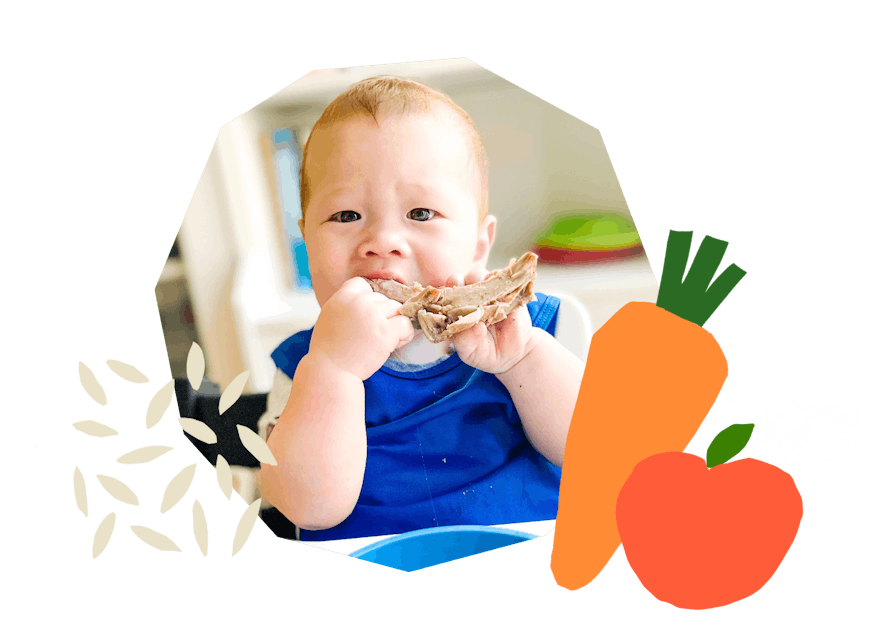
The Program Baby-Led Weaning with Katie Ferraro
A step-by-step digital program for starting solid foods safely and navigating the original 100 FIRST FOODS™ meal plan with baby-led weaning.
 EXPERT-LED, PROVEN APPROACH TO EATING REAL FOOD
EXPERT-LED, PROVEN APPROACH TO EATING REAL FOOD CONCISE VIDEO TRAININGS TO MASTER BABY-LED WEANING
CONCISE VIDEO TRAININGS TO MASTER BABY-LED WEANING 100 FIRST FOODS DAILY MEAL PLAN WITH FOOD PREP VIDEOS
100 FIRST FOODS DAILY MEAL PLAN WITH FOOD PREP VIDEOS
Baby-Led Weaning for Beginners Free Workshop
Is your baby ready to start solid foods, but you’re not sure where to start? Get ready to give your baby a solid foundation to a lifetime of loving real food…even if you’re feeling overwhelmed or confused about this next stage of infant feeding.
Get baby-led weaning recipes and tips delivered to your email inbox.


